

|
History of St. Luke Lutheran Church
Olney, Texas 1982 |
To appreciate the history of this congregation, we must look back to the year 1871. The congregation at Olney is often referred to as the Kunkel Congregation. This name is not as inappropriate as it may appear. In 1937 there were 64 souls out of 200 members bearing the name of Kunkel. In 1982 there are 101 out of 280 that bear the name or have Kunkel blood in their ancestry. Where did they come from? This may form an interesting chapter in itself. |
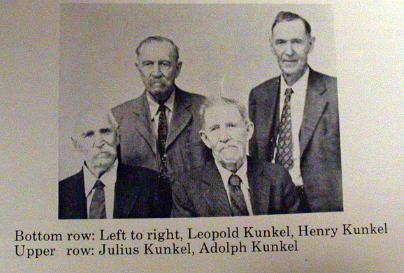 |
| In 1884, William Bernhardt received a visitor from Lee County, his cousin, William Meissner, a bachelor, also known as "Schuster" Meisnner. He brought with him a Bible, a prayer book, and a devotional book, a so-called "Hauspostille." With the aid of these books the Kunkel families resolved to assemple in their rock and log cabins for religious services. Henry Kunkel conducted the reading services. Sunday School was also introduced. Henry Kunkel instructed the seniors and Leopold the juniors. Thus the Kunkel families regularly had their reading services and Sunday School. |
|
First Lutheran Pastor
|
| In 1886, Julius Kinkel and family moved to Clifton, Texas. Here a little flock was being served by a Lutheran Pastor, Bartels, by name from Hamilton County. This was good news. This good news was soon sent on its way to Young County. Also the address of Rev. Johannes Bartels was forwarded to Henry Kunkel. Soon after, Rev. Bartels received an invitation to come to Young County to conduct services and to baptize the children. He came, baptized 11 children and remained for a week. He was the first Lutheran pastor to render the first religious service to our Lutheran pioneers at Olney. |
|
Other Lutheran Pastors
|
| Due to Pastor Bartels' efforts the little flock in Young County was now served regularly. In 1887 and 1888 it was served from Dallas by Pastor Ruhland; by Rev. Heier in the first part and Rev. John Schulenburg in the latter part of 1889. The latter made his home in Fort Worth and also served the following places: Bridgeport, Decatur, Wichita Falls, Iowa Park, Vernon and Olney. Rev. John Schulenburg returned to his home in Minnesota in 1894 and was succeeded by Rev. Melhorn. Serving the various places mentioned before for and about one and one-half years he was drenched by heavy rain on one of his trips, contracted pneumonia, and passed to his eternal reward on 24 January 1896. |
|
Congregation Organized
|
After Rev. Melhorn's departure the entire field became orphaned until 6 September 1896. Pastor F.M. Rudi was then called by the mission board, ordained and installed in this vast field on the afore mentioned date. In the second year of his missionary activities, on Reformation Day, 31 October 1897, he organized St. Luke Lutheran Congregation at Olney, Texas.
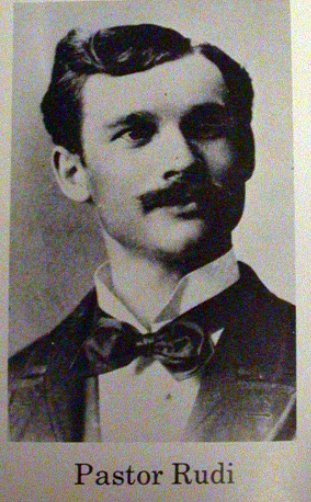 |
Organized with Eight Voting Members |
| The congregation was organized with eight voting members. They were: Henry Kunkel, Emil Kunkel, William Bernhardt, Wilhelm Kunkel, Leopold Kunkel, Julius Kunkel, Adolph Kunkel and Charles W. Junker, who had married Emma Kunkel. Henry Kunkel was elected first elder and chairman of the congregation for a period of three years; Emil Kunkel was elected for two years, and William Bernhardt one year. Emil Kunkel was also elected secretary. Charles W. Junker was elected treasurer. |
|
First Resident Pastor
|
Pastor F.M. Rudi who organized this congregation served until 1901. In this year he accepted a call to the congregation at Clara. A vacancy of four months followed during which the field was served by a student of our St. Louis seminary, Mr. August Maerz. On 1 September 1901, Pastor G.A. Obenhaus, who, as a student, had assisted Pastor F.M. Rudi in 1899 and 1900, was installed by Pastor Rudi to serve this field. Due to the extensiveness of the field the mission board in the fall of 1903 employed a student from our St. Louis seminary, Mr. Theo Gutknecht, to assist Pastor Obenhaus. Mr. Gutknecht had charge of Olney and served from July 1903 until January 1904. On 25 November 1904 the mission board transferred Pastor Obenhaus to Olney and thus he became the first resident pastor. Since the congregation possessed no church property, his first problem was to find a place to live. He purchased approximately 33 acres joining the Terrapin School land, with a two room box house from Mr. F. Mullfinger, teacher of the Terrapin School District. Later he added two rooms to the box house, and this four room house served as the first parsonage until 1914. In the month of March 1908, Pastor Obenhaus accepted a call to Lexington, Texas. When he left Olney the congregation bought the 33 acres of land with the four room dwelling from Pastor Obenhaus for the sum of $400.00. 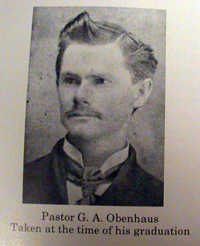 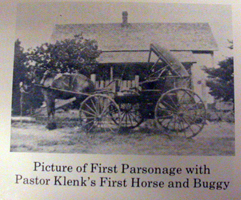 |
|
Other Pastors until 1912
|
Rev. Obenhaus was succeeded in 1908 by Rev. O. Lugenheim, an elderly man from Wisconsin. He served until September 1911 and was succeeded by Rev. E. Deffner from Wichita Falls. After a brief stay of six months Rev. Deffner accepted a call to Klein, now called Spring, Texas. Rev. A. Bohot in Fort Worth was called, but declined. Being subsidized by the mission board the congregation placed the matter concerning the new man for Olney into the hands of the board. 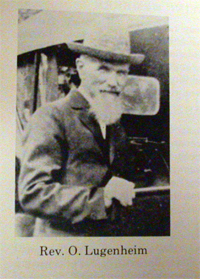 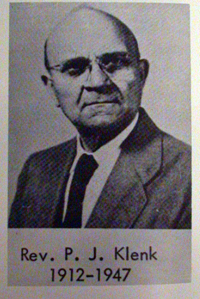 |
|
Pastors and Events After 1912
|
The mission board now submitted the call to the college of presidents for a candidate. The college of presidents assigned this call to Rev. P.J. Klenk, who accepted the call and arrived in Olney 1 August 1912. He was ordained and installed by the Rev. C.M. Beyer on 1 August 1912. On 7 December 1913, he was married to Miss Alwina Kunkel, daughter of Gustav A. Kunkel. 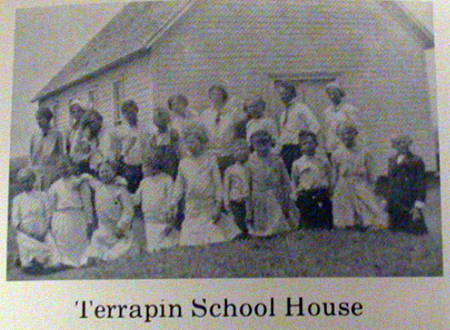 Pastor Klenk now leading St. Luke, the resolution passed in August 1912 to have a Mission Festival on the fourth Sunday of September, has become a tradition that is still observed through 1982. The only major change from this Mission Festival Sunday would be that both morning and afternoon services are conducted in English. In January 1913, the congregation resolved to become self supporting, and has been growing ever since. The progress of St. Luke can be seen in the pictures of the first place of worship being the Terrapin School House, a building built by the Kunkel brothers and other patrons of the Terrapin School District and the First Church. The Terrapin School House served as a place of worship until 1914. In the regular fall meeting conducted in November 1913, a resolution to erect a house of worship, which was to be 28x48x14 feet, was passed. It was not erected on the old property, of the congregation, previously mentioned, but on a five acre tract presented by Mr. Otto Deitrich, 2.8 miles northwest of Olney. The cost of this building was $1,225.00. Each and every member obligated himself to donate one week of labor. Thus, under the supervision of J.A. Norton, a Presbyterian, the first church was erected. The building was dedicated to the serve of the Lord on 1 February 1914, Rev. G.A. Obenhaus from Lexington, Texas, delivered the sermon in the German language and the local pastor the dedicatory sermon in the English language. In a regular meeting conducted in March of the same year this resolution was passed: Resolved to move the two rooms of the parsonage erected by Pastor Obenhaus and to tear down and rebuild the two box rooms erected by Mr. Mullfinger. In this picture of the first church you have a view of the second parsonage. It was identical with the first parsonage, but it had two much larger rooms. 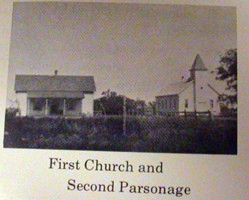 In the course of time, 11 years, the first church building became too small to accomodate the people who assembled there for public worship. Since the Lord had showered His blessings down upon the people, they resolved to express their sincere gratitude to the Lord in the erection of a new house of worship. In the regular meeting conducted on 11 October 1925, it was resolved to erect this church, a structure 36x48x20 feet of brick and tile, with a full basement one-third below ground. The following members served on the building committee: J.O. Winkler, Ben Schlegel, W.J. Kunkel, C.F. Kunkel and Ben Jeske. Because of ill health Mr. O. Deitrich was excused from serving on this committee. The contract of this building was awarded to D.N. Darnell Brothers of Abileen, Texas. Voelker and Dixon, Wichita Falls, Texas, served as architects. The contract price of the building was $19,360.00. To this amount must be added the cost of the pews, $1,600.00, the pulpit, $175.00 and the altar, $225.00. A bell was donated by the following members: H.D. Kunkel, J.M. Kunkel, W.J. Kunkel, R.H. Rachuig, Ben Schlegel, G.A. Lauster, B.R. Jeske and J.O. Winkler, at a cost of $440.00. A delco plant was donated by J.O. Winkler and W.J. Kunkel, at a cost of $600.00. An Estey organ was donated by C.F. Kunkel at a cost of $232.00. Altar and pulpit coverings and hangings were donated by the ladies of the congregation. The total cost of the building and furnishings amounted to approximately $25,000.00. It was dedicated to the service of the Lord on 15 August 1926. Rev. H. Studtmann, then pastor of the congregation at Riesel, Texas, preached the German and Rev. C.M. Beyer of Wichita Falls, delivered the English dedicatory sermons. 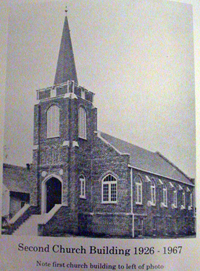 Since the parsonage was to small to conveniently accommodate the pastor's family and no longer in harmony with the church, the congregation in one of its regular meetings of 1927 resolved to tear down born the other church and the old parsonage and build a new parsonage. A new parsonage was erected in the spring of 1927 and dedicated in June of the same year at the cost of $3,500.00. The parsonage was an eight room house including a bath.  |
|
Christian Day School
|
Beginning with September 1914, a Christian Day School was established. The enrollment for the first year was very small, comprised of six pupils. For the second year the enrollment was eight. This school was taught by the pastor himself for 13 years. In the scholastic year of 1925 and 1926 the enrollment was 36 pupils, the highest in the history of the school. Beginning with the fall of 1926, a lady was employed. Miss Johanna Schwausch of Walburg, Texas, taught the school for four consecutive years. In the following years beginning with 1930, the following theological students in our seminary in St. Louis, and Springfield, Illinois, taught, namely: Werner Barlau, Young America, Minnesota, 1930-1931 A.O. Kaltwasser, Vernon, Texas, 1931-1932 Ewald Recks, Perry, Oklahoma, 1932-1933 Lylas Groth, Merrill, Wisconsin, 1933-1935 W.S. Graumann, Granite, Oklahoma, 1935-1936 A. Hornbostel, Duluth, Kansas, 1936-1937 F. Gumz, Gadott, Wisconsin, 1937-1938 Weiser, 1939-1940 Heber, 1940-1941 Pastor Klenk, 1942-1947 Rev. Oscar Horn accepted our call and was installed as our pastor on 7 September 1947. He remained here until 1 July 1950. During his stay as pastor, he worked very diligently with St Luke Sunday School system spending much time training teachers. Also much time and effort was devoted to Sunday School materials and memory programs. Bible Class was also usually reported to be a full house. The basement of the church was divided into various classrooms by sliding cloth curtains. A closed in office area in the southeast corner of the basement was also added with a kitchen area added to the northeast corner.  On 27 August 1950, the Rev. Richard M. Brandt was installed and remained until 31 July 1955. During Pastor Brandt's stay the altar and the altar area was remodeled with a communion rail added.  After six months on 8 January 1956 installed was Rev. Alfred Scholz who stayed with us until September 1960. Pastor Scholz was instrumental in helping St. Luke establish a sister congregation in Graham. He conducted the first Lutheran worship service on 10 March 1957. The congregation worshipped under the name of Good Shepherd Lutheran Church for several years. It is now known as Faith Lutheran Church, having organized on 24 May 1970 under the leadership of Rev. H.A. Heckmann. 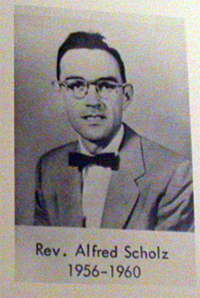 Rev G.W. Heinemeier accepted our call and was installed as our pastor on 4 December 1960. He remained until April 1963. While Pastor Heinemeier was pastor the church building became structurally unsound and out-dated, which brought about the motion to rebuild. 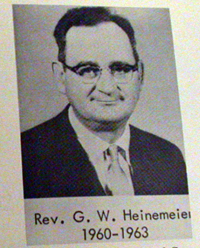 Our next pastor came as a seminary graduate and was installed 8 September 1963. He led us until 4 February 1968. He was Rev. R.C. Gauger. Rev. Gauger helped start a weekday school program which has been very successful and has been a blessing to many children as they work through the eight year curriculum that ends with confirmation. The building program was also organized during Pastor Gauger's ministry. The decision to build the facilities in town was made. The search for city property began. First, property west of Hamilton Hospital with a house they could serve as the parsonage was purchased. Before any building plans were decided upon, the inadequacy of the site was realized. The search for more property led to the present location where 13 acres was purchased on 1 August 1965. Within two years, 25 June 1967, the present church building had been completed and dedicated. 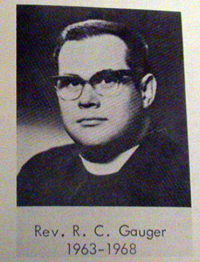 While removing our old bell that was sent to the factory to be equipped with an electric ringer, it was found to be cracked and therefore unsuitable to be placed in the new bell tower. A new one had to be purchased. Our pulpit from the old building was donated to the Young County Historical Commission and was placed in the chapel at Fort Belknap, Texas. Our next shepherd is Rev. H.A. Heckmann, who was installed on 11 August 1968 and continues to lead in 1982. Pastor Heckmann only lived in the rural parsonage a few months when the congregation was able to purchase the present parsonage located at 303 N. Avenue O. This led to the sale of the rural property. 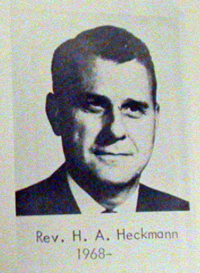 Our sister congregation in Graham, also under the leadership of Pastor Heckmann, was able to build and dedicate the permanent facilities in Graham on 11 September 1977. The congregation in the fall of 1981 decided to enter a vicar program that would enable our pastor to better serve our two congregations. Vicar Charles Baker was assigned to St. Luke for a one year stay. He arrived March 1982. |
|
Notes on Our Organs, Past and Present
|
| Our original organ from the wooden church building was moved into the basement of the second church building and used for choir practice before being given to the Lutheran Church at Albany, Texas. A second organ, an Estey organ was donated and dedicated with a new building in 1926 and later given to the Big Spring Lutheran congregation, former charge of Pastor Horn. A Hammond organ was donated in 1947 in memory of Arnold Jeske, who died in World War II. The fourth and present Reuter Pipe organ was purchased by the congregation for $34,930. A dedication service was held on 6 May 1979. The Hammond organ was given to Erna Jeske Lauschke as a token of appreciation for her years of service as organist. A Texas Historical Commission marker was placed at St. Luke in 1979 and was placed in front of the sanctuary. |